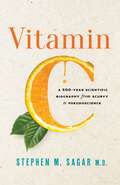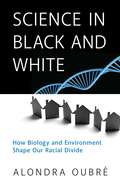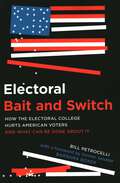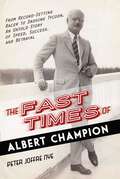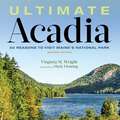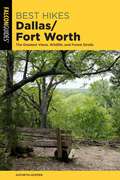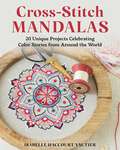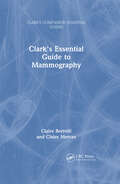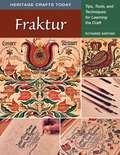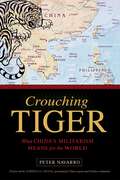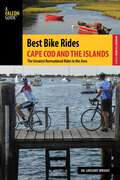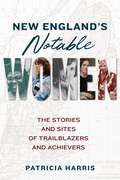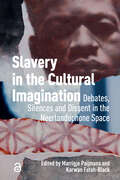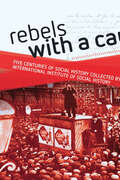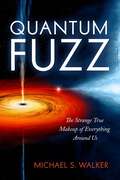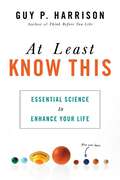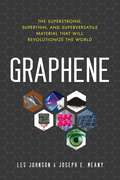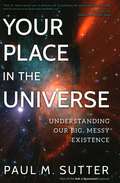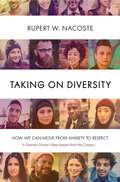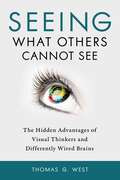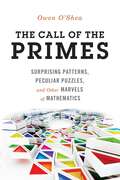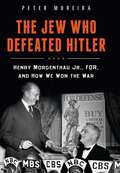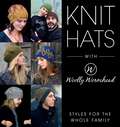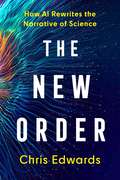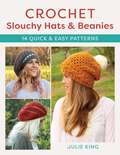- Table View
- List View
Vitamin C: A 500-Year Scientific Biography from Scurvy to Pseudoscience
by Stephen M. Sagar M.D.Vitamin C: A 500-Year Scientific Biography from Scurvy to Pseudoscience is the compelling story of the history and science behind vitamin C.Vitamin C begins with scurvy, which afflicted Europe for four hundred years and killed millions. The reasons that a disease whose cure was known from the outset persisted over that time are at once baffling and familiar, and these trials eventually lead to invention of the science of epidemiology. Author Stephen M. Sagar MD then chronicles the discovery of vitamins at the beginning of the twentieth century, a story that encapsulates the rise of a scientific approach to nutrition but with surprising twists and turns. As vitamin science became more acquainted with the mainstream, scientist Linus Pauling reached new heights of fame and influence by popularizing the practice of taking megadoses of vitamin C to prevent colds – a claim that was not necessarily backed by data. This kickstarted the growth of the $40 billion vitamin and supplement industry, which has since prospered all while ignoring science. This unique and engrossing narrative reveals how medical science functions in the real world and how it has changed over the centuries. Featuring swashbuckling sailors, arctic explorers, penny-pinching bureaucrats, academicians with clashing egos, and intrepid scientists working in malaria-infested jungle laboratories, the story of C is in many ways the story of how science gets done (and undone). From the trial and error of early explorers to the scientific breakthroughs made by biochemists and the birth of the modern supplement industry, this revelatory book tells the story of how cherished beliefs, self-interest, and politics often intertwine with scientific progress.
Science in Black and White: How Biology and Environment Shape Our Racial Divide
by Alondra OubreThis unflinching expose of racially biased research--the Alt-Right's "scientific wing"--debunks both old and emerging claims of inborn racial disparities.Racial groups differ in some of their social patterns, but the cause of those differences--nature versus nurture, or genetics versus environment-- remains fiercely debated. For the pro-nature camp-- sometimes aligned with white nationalism and eugenics, and often used to promote ideas of racial inferiority and superiority -- race-based biological determinism contributes significantly to the ethnic divide, especially the black/white gap in societal achievement. By contrast, pro-nurture supporters attribute ethnic variation in social outcomes primarily to environmental circumstances, ecological conditions, and personal experience. In this thoroughly researched book, science writer Alondra Oubre examines emerging scientific discoveries that show how both biology and environment interact to influence IQ--intelligence performance--and social behaviors across continental populations, or human races. She presents compelling evidence for why environmental and certain non-DNA-related biological phenomena overall seem to best explain black/white disparities in a gamut of social behaviors, including family structure, parenting, educational attainment, and rates of violent crime. As she demonstrates, nature still matters, but the biology that impacts racial variance in social behaviors extends beyond genetics to include other processes--epigenetics, gene expression, and plasticity--all of which are profoundly affected by a wide array of environmental forces. The complex, synergistic interplay of these factors combined, rather than just genes or just environment, appears to account for black/white divergence in a gamut of social behaviors.
Electoral Bait and Switch: How the Electoral College Hurts American Voters and What Can Be Done about It
by Bill PetrocelliIt&’s a system that now fosters massive inequality in voting rights and opens the door to manipulation of presidential elections by foreign and domestic enemies of democracy. Electoral Bait & Switch is prescriptive, and accessible to the general reader.The current Electoral-Vote system presents a severe and growing threat to democracy in the United States. It has thwarted the will of a majority of the voters twice in the last five presidential elections (2000 and 2016) by elevating to office a candidate who received only a minority of the vote. This system is a distortion of the system envisioned by Alexander Hamilton, James Madison and the other framers of the Constitution. If it is not challenged and overturned, we are likely to face a continual series of electoral and constitutional crises.The constitutional right of Americans to an equal vote in presidential elections is being violated by this system on a massive scale. The value of an individual vote varies as much as three-to-one from state to state, and there are no two states where voters have the same voting-power. The current Elector system discriminates heavily against minority and poorer voters. The winner-take-all method of allocating Electoral votes also results in large pockets of &“useless votes&” and a system in which where you vote counts for far more than how you vote. Most ominously, evidence is now clear that the Electoral-Vote system has opened the door for voter suppression and manipulation of elections by domestic and foreign conspirators.
The Fast Times of Albert Champion: From Record-Setting Racer to Dashing Tycoon, An Untold Story of Speed, Success, and Betrayal
by Peter Joffre NyeRACER. INNOVATOR. CELEBRITY. MOGUL. CHAMPION. This is the first biography of the short but exciting life of Albert Champion-record-setting bicyclist and motorcyclist, daredevil racecar driver, early automobile innovator, charismatic ladies' man, and celebrity of the Jazz Age. Though most Americans have heard of the companies Albert Champion founded-ACDelco and Champion Spark Plug-few know much about the charismatic man behind them.Like a Richard Branson of the early 20th century, or an Evel Knievel with a business degree, Champion was a powerhouse whose life was defined by both speed and success. Champion rose from poverty in Paris to great wealth and fame in both his native France and the United States. As a bicycle racer, Champion set more than a hundred world records. When the urban speed limit was 8 mph, he was the first ever to drive a motorcycle a mile under a minute. A car-racing crash snapped a leg bone that kept him in traction for eleven weeks. Undeterred, he hobbled out of the hospital on crutches and recovered to win the French national cycling championship. Champion invested his prize money to become a tycoon in the new and revolutionary American auto industry, working closely with the leading players and amassing thirty US. His contemporaries included Charles Lindbergh, who endorsed Champion's product by saying, "AC Spark Plugs kept my engine running perfectly."; Louis Chevrolet, whom Champion backed financially until it came out that he was trying to seduce Chevrolet's wife, which led to a fight and the end of their friendship; and William Durant, founder of a "new holding company" called General Motors. A notorious ladies' man, Champion's many dalliances were fodder for the papers and finally ended in a love triangle that resulted in his death under mysterious circumstances.
Ultimate Acadia: 50 Reasons to Visit Maine's National Park
by Virginia M. WrightUltimate Acadia is the essential book about Maine's Mount Desert Island, providing everything you need to know to make the most of your time there. Thoroughly revised and updated, the book is compiled as a kind of bucket list, suggesting 50 things to do and see to make the absolute most of your time in Acadia National Park, Bar Harbor, and the surrounding villages and environs. It includes history, natural history, geology, profiles of prominent and popular institutions, and loads of useful insider information. This fun, accessible guide is the book to buy before you go to Acadia, and the book to take with you when you leave.
Best Hikes Dallas/Fort Worth: The Greatest Views, Wildlife, and Forest Strolls (Best Hikes Near Series)
by Kathryn HopperWho says you have to travel far from home to go on a great hike? In Best Hikes Dallas and Forth Worth author Kathryn Hopper details the best hikes within an hour's drive of the greater Dallas and Fort Worth area perfect for the urban and suburbanite hard-pressed to find great outdoor activities close to home. Each featured hike includes detailed hike specs, a brief hike description, trailhead location, directional cues, and a detailed map.
Cross-Stitch Mandalas: 20 Unique Projects Celebrating Color Stories from Around the World
by Isabelle Haccourt VautierImmerse yourself in serenity with 20 stunning mandalas for cross-stitch, each inspired by global destinations, blending intricate designs with color symbolism to create beautiful, calming art for your home!Mandalas are intricate circular designs used around the world to invoke calm through reflection. In recent times, drawing, coloring, and painting mandalas have become popular ways to seek out this inner serenity. It is in this spirit that the talented embroiderer Isabelle Haccourt Vautier offers 20 mandalas inspired by cities and countries she dreams of visiting. Using her imagination and knowledge of the places&’ histories and traditions, she has created breathtaking mandalas that celebrate the spirit of each destination.Completed pieces are shown finished in a variety of ways: wall hangings and banners, pouches and totes, pincushions, tea towels, and more. Each design includes a list of fabrics and embroidery floss colors used and detailed cross-stitch charts. Both stitching and admiring these stunning mandalas will transport you to a place of calm and joy!
Clark's Essential Guide to Mammography (Clark's Companion Essential Guides)
by Claire Mercer Claire BorrelliThis easy-to-understand pocketbook in the highly respected Clark’s stable of imaging texts is an invaluable tool and training aid, providing essential information for mammographic positioning, technique and interpretation for mammography practitioners at all levels.Adopting a systematic and structured approach facilitating rapid reference in the clinical setting, the book covers general principles and all routine mammographic projections, including additional and adapted projections covered in a separate section, and is highly illustrated with clear explanatory line diagrams and imaging photographs.Clark’s Essential Guide to Mammography is ideal as an educational tool for trainee mammographers, trainee assistant and associate apprenticeship mammographers, mammography training teams and universities delivering mammography education and a convenient clinical guide for practising mammographers, including assistant and associate apprenticeship mammographers.
Fraktur: Tips, Tools, and Techniques for Learning the Craft
by Ruthanne HartungThe Pennsylvania Dutch are noted for the beautifully designed and hand-lettered documents known as fraktur. These include birth and marriage certificates, family trees, bookplates, awards, and house blessings. Leading fraktur artist Ruthanne Hartung adapts the craft to modern tastes and needs in this practical how-to book, with information on tools, step-by-step instructions, ideas for design, lettering and coloring techniques, and a variety of projects. An assortment of traditional patterns to apply to personal frakturs are included.
Crouching Tiger: What China's Militarism Means for the World
by Peter NavarroWill there be war with China? This book provides the most complete and accurate assessment of the probability of conflict between the United States and the rising Asian superpower. Equally important, it lays out an in-depth analysis of the possible pathways to peace. Written like a geopolitical detective story, the narrative encourages reader interaction by starting each chapter with an intriguing question that often challenges conventional wisdom. Based on interviews with more than thirty top experts, the author highlights a number of disturbing facts about China's recent military buildup and the shifting balance of power in Asia: the Chinese are deploying game-changing "carrier killer" ballistic missiles; some of America's supposed allies in Europe and Asia are selling highly lethal weapons systems to China in a perverse twist on globalization; and, on the U.S. side, debilitating cutbacks in the military budget send a message to the world that America is not serious about its "pivot to Asia." In the face of these threatening developments, the book stresses the importance of maintaining US military strength and preparedness and strengthening alliances, while warning against a complacent optimism that relies on economic engagement, negotiations, and nuclear deterrence to ensure peace. Accessible to readers from all walks of life, this multidisciplinary work blends geopolitics, economics, history, international relations, military doctrine, and political science to provide a better understanding of one of the most vexing problems facing the world.
Best Bike Rides Cape Cod and the Islands: The Greatest Recreational Rides in the Area (Best Bike Rides Series)
by Gregory WrightBest Bike Rides Cape Cod and the Islands describes 40 of the greatest recreational rides in the Cape Cod area. Road rides, rail trails, bike paths, and single-track mountain bike rides all get included. Most rides are in the 5- to 35-mile range, allowing for great afternoon outings and family adventures. Best Bike Rides Cape Cod and the Islands includes a map of each ride, a log of significant milepoints, a text description of the ride, a start-finish point with nearby motor vehicle parking, the GPS coordinates of the start-finish point, and color photos. Also included is information on local restaurants, lodging, maps, bicycle shops, other facilities for cyclists, and community resources.
New England's Notable Women: The Stories and Sites of Trailblazers and Achievers
by Patricia HarrisNew England has nurtured countless women who shook off traditional gender roles to forge their own destinies. Their achievements are legion. Narragansett tribal historian Princess Red Wing served as a delegate to the United Nations and co-founded Rhode Island&’s Tomaquag Museum. Boston iconoclast Isabella Stewart Gardner had the acute artistic vision to establish the museum that bears her name. Harriet Beecher Stowe ignited public opinion against slavery, arguably hastening the Civil War, as displays in her Hartford home make clear. Pioneering naturalist Rachel Carson jumpstarted the modern environmental movement with her writings about the rocky beaches and quivering tidepools of Southport, Maine. New England's Notable Women shines the spotlight on 45 of these trailblazers and achievers and directs readers to the homes and sites throughout New England where their stories come to life.
Slavery in the Cultural Imagination: Debates, Silences, and Dissent in the Neerlandophone Space (Slavery and Emancipation)
by Karwan Fatah-Black Marrigje PaijmansWith the rising tide of scholarly and societal interest in the history and legacy of colonialism and slavery, this collection offers a much-needed diachronic analysis of the cultural representations of the lives and afterlives of those subjected to slavery and indenture. It focuses on the history of the ‘neerlandophone’ space, defined as the complex linguistic space spanning former Dutch colonies. This collection gives a longue durée overview, with cases from the early modern period to the present day, revealing the deep roots of the colonial ‘cultural archive’. Scholars from a wide variety of disciplines demonstrate how attention to the layered and polyphonic qualities of narratives can reveal silent and disruptive voices in colonial discourse, as well as collective emotions and imaginations that have hitherto remained unrecorded in historical sources. They discuss different aesthetic, poetic, and storytelling practices, including literature, archival and legal documents, performance, architecture, photography, and philosophy, formed both in the metropolis and by enslaved and indentured peoples in the colonies.
Rebels with a cause: Five centuries of social history collected by the International Institute of Social History
by Jan Lucassen Jaap KloostermanEvery age has had its rebels: socialists, peace activists, sexual reformers, fundamentalists, and more. The collections of the International Institute of Social History (IISH) in Amsterdam are full of them. The IISH is the world's largest documentation centre in the field of social history and emancipation movements. This book looks back on seventy-five years of the IISH and its collections, with a focus on creative ideas and people who fought for radical change, from Karl Marx to Aung San Suu Kyi, the French Revolution to the Chinese student revolt of 1989, from the early modern world explorers to today's anti-globalists.
Quantum Fuzz: The Strange True Makeup of Everything Around Us
by Michael S. WalkerQuantum physics has turned our commonsense notion of reality on its head. This accessible book describes in layperson's terms the strange phenomena that exist at the quantum level--a world of tiny dimensions where nothing is absolutely predictable, where we rethink causality, and information seemingly travels faster than light. The author, a veteran physicist, uses illuminating analogies and jargon-free language to illustrate the basic principles of the subatomic world and show how they explain everything from the chemistry around us to the formation of galaxies. He also explains how scientists and engineers interact with this nebulous reality and, despite its mysteries, achieve results of great precision.Up front is a brief history of the early 20th-century "quantum revolution," focusing on some of the brilliant individuals whose contributions changed our view of the world--Albert Einstein, Niels Bohr, Paul Dirac, Werner Heisenberg, Erwin Schroedinger, and others. The work concludes with a discussion of the many amazing inventions that have resulted from quantum theory, including lasers, semiconductors, and the myriad of electronic devices that use them.Lucidly written, this book conveys the excitement of discovery while expanding the reader's appreciation for a science that explores the basis of everything we know.
At Least Know This: Essential Science to Enhance Your Life
by Guy P. HarrisonThis primer on essential scientific literacy gives readers the basics to understand themselves and the world around them, plus a glimpse of how much more science has to offer. Science tells us a good deal about who we are, where we come from, the nature of the universe, how our brains work, and much, much more. Unfortunately, most people are largely unaware of this treasure trove of information. As a result, we are more prone to do things like aim nuclear weapons at each other, inflate the meaning of cultural differences, lay waste to the land, poison and deplete the oceans, fill the sky with carbon, and generally make poor judgments that cause needless trouble. This book seeks to remedy this situation by providing scientific answers to the most basic yet important questions about existence. Following the standard six-question list used by journalists researching a news story, critical-thinking advocate Guy P. Harrison turns to science to answer the who, what, why, when, where and how of life on Earth. How old is our planet? Where did it come from and where is it located in the universe? What is everything made of? When did life begin? Who are we as a species and what connections do we share with other life forms? Why is human culture continuously plagued by war, disease, and crime? Harrison not only offers science's best current answers to these crucial questions but shows how all of this information fits together. Going well beyond the simplistic factoids readily available on any smartphone, he reveals the wider implications and deeper meanings inherent in the scientific worldview. Both entertaining and informative, this exciting tour of the cosmos and human nature will leave readers with an accurate, up-to-date view of realities small and large, near and far.
Graphene: The Superstrong, Superthin, and Superversatile Material That Will Revolutionize the World
by Les Johnson Joseph E. MeanyTwo scientists give an enthusiastic, layperson's overview of a new supermaterial now in development that could transform many features of daily life, from creating new conveniences to improving health and safety. What if you discovered an infinitesimally thin material capable of conducting electricity, able to suspend millions of times its own weight, and yet porous enough to filter the murkiest water? And what if this incredible substance is created from the same element that fills the common pencil? That's graphene--a flat, two-dimensional, carbon-based molecule with a single sheet measuring only one atom thick. In this layperson's introduction to this revolutionary substance, a physicist and a chemist explain how graphene was developed, discuss the problems in scaling up production for large-scale commercial use, and forecast the potentially transformative effects of incorporating graphene into everyday life. Recent research developments include adding graphene to Silly Putty to make extremely sensitive and malleable medical sensors and compressing and fusing flakes of graphene to create a three-dimensional material that's ten times stronger than steel. This widely adaptable substance promises to change the way we interact with smartphones, laptops, information storage, and even condoms. It may also enable significant improvements to air purification, water filtration technologies, and drug delivery. This entertaining and widely accessible book offers a fascinating look into one of the most exciting developments in materials science in recent decades.
Your Place in the Universe: Understanding Our Big, Messy Existence
by Paul M. SutterAn astrophysicist presents an in-depth yet accessible tour of the universe for lay readers, while conveying the excitement of astronomy. How is a galaxy billions of lightyears away connected to us? Is our home nothing more than a tiny speck of blue in an ocean of night? In this exciting tour of a universe far larger than we can imagine, cosmologist Paul M. Sutter emphasizes how amazing it is that we are part of such a huge, complex, and mysterious place. Through metaphors and uncomplicated language, Sutter breathes life into the science of astrophysics, unveiling how particles, forces, and fields interplay to create the greatest of cosmic dramas. Touched with the author's characteristic breezy, conversational style--which has made him a breakout hit on venues such as The Weather Channel, the Science Channel, and his own popularAsk a Spaceman!podcast--he conveys the fun and wonder of delving deeply into the physical processes of the natural universe. He weaves together the past and future histories of our universe with grounded descriptions of essential modern-day physics as well as speculations based on the latest research in cosmology. Topics include our place in the Milky Way galaxy; the cosmic web--a vast web-like pattern in which galaxies are arranged; the origins of our universe in the big bang; the mysteries of dark matter and dark energy; how science has dramatically changed our relationship to the cosmos; conjectures about the future of reality as we know it; and more. For anyone who has ever stared at the starry night sky and wondered how we humans on Earth fit into the big picture, this book is an essential roadmap.
Taking on Diversity: How We Can Move from Anxiety to Respect
by Rupert W. NacosteIn this enlightening book, a campus "diversity doctor" relatesstories that individuals have shared with him about their anxieties in situations involving people who are in some way different than themselves. Dr. Rupert W. Nacoste regularly counsels students at North Carolina State University about their problems dealing with diversity of all kinds, including of gender, race, ethnicity, and sexual-orientation. Here, he shares his most effective techniques for handling the unavoidable realities of being in a neo-diverse community, whether that means in college or America as a nation. The author's proven "safe space" strategy can be applied to the campus, community groups, churches, and workplaces as a means to facilitate positive dialogue about diversity. In this time of current tensions, students, or "young travelers" as Nacoste fondly refers to them, still have much work ahead of them to achieve mutual respect and understanding. From everyday encounters, parties, and email and social media exchanges, they provide examples of ongoing bigotry: racial slurs and stereotypes are still used; young men continue to project demeaning attitudes toward women; and the heterosexual majority sometimes shows little understanding of the LBGT minority. Dr. Nacoste considers it his role to usher students off the "Wrong-Line train," and he has noticed that as they "leave the station," adults begin to follow their lead. The author demonstrates how we can maintain fairness and respect while still acknowledging our differences. By doing so, we can all learn to meet these challenges using sensitivity to different perspectives, open-minded attitudes, and the recognition that diversity in America is here to stay.
Seeing What Others Cannot See: The Hidden Advantages of Visual Thinkers and Differently Wired Brains
by Thomas G. WestFor over 25 years, Thomas G. West has been a leading advocate for the importance of visual thinking, visual technologies and the creative potential of individuals with dyslexia and other learning differences. In this new book, he investigates how different kinds of brains and different ways of thinking can help to make discoveries and solve problems in innovative and unexpected ways. West focuses on what he has learned over the years from a group of extraordinarily creative, intelligent, and interesting people — those with dyslexia, Asperger's syndrome, and other different ways of thinking, learning, and working. He shows that such people can provide important insights missed by experts as they also can prevent institutional "group think." Based on first-person accounts, West tells stories that include a dyslexic paleontologist in Montana, a special effects tech who worked for Pink Floyd and Kiss and who is now an advocate for those with Asperger's syndrome, a group of dyslexic master code breakers in a British electronic intelligence organization, a Colorado livestock handling expert who has become a forceful advocate for those with autism and a family of dyslexics and visual thinkers in Britain that includes four winners of the Nobel Prize in Physics. He also discusses persistent controversies and the unfolding science. This is an inspiring book that not only documents the achievements of people with various learning differences, but reveals their great potential — especially in a new digital age where traditional clerical and academic skills are less and less important while an ability to think in pictures and to understand patterns using high-level computer information visualizations is rapidly increasing in value in the global economic marketplace.
Call of the Primes: Surprising Patterns, Peculiar Puzzles, and Other Marvels of Mathematics
by Owen O'SheaThis sampler of entertaining mathematical diversions reveals the elegance and extraordinary usefulness of mathematics for readers who think they have no aptitude for the subject. If you like any kind of game at all, you'll enjoy the amazing mathematical puzzles and patterns presented here in straightforward terms that any layperson can understand. From magic squares and the mysterious qualities of prime numbers to Pythagorean triples, probability theory, the Fibonacci sequence, and more, the author shows that math can be fun while having some profound implications. Such ubiquitous mathematical entities as pi and the Fibonacci numbers are found throughout the natural world and are also the foundation of our technological civilization. By exploring the intriguing games presented here, you'll come away with a greater appreciation for the beauty and importance of these and many more math concepts. This is the perfect book for people who were turned off by math in school but now as adults wonder what they may have missed.
Jew Who Defeated Hitler: Henry Morgenthau Jr., FDR, and How We Won The War
by Peter MoreiraPresident Franklin D. Roosevelt coined the slogan "The Arsenal of Democracy" to describe American might during the grim years of World War II. The man who financed that arsenal was his Secretary of the Treasury, Henry Morgenthau Jr. This is the first book to focus on the wartime achievements of this unlikely hero-a dyslexic college dropout who turned himself into a forceful and efficient administrator and then exceeded even Roosevelt in his determination to defeat the Nazis. Based on extensive research at the FDR Library in Hyde Park, NY, author Peter Moreira describes Morgenthau's truly breathtaking accomplishments: He led the greatest financial program the world has ever seen, raising $310 billion (over $4.8 trillion in today's dollars) to finance the war effort. This was largely done without the help of Wall Street by appealing to the patriotism of the average citizen through the sale of war bonds. In addition, he championed aid to Britain before America entered the war; initiated and oversaw the War Refugee Board, spearheading the rescue of 200,000 Jews from the Nazis; and became the architect of the 1944 Bretton Woods Conference, which produced the modern economic paradigm. The book also chronicles Morgenthau's many challenges, ranging from anti-Semitism to the postwar "Morgenthau Plan" that was his undoing. This is a captivating story about an understated and often overlooked member of the Roosevelt cabinet who played a pivotal role in the American war effort to defeat the Nazis.
Knit Hats with Woolly Wormhead: Styles for the Whole Family
by Woolly WormheadInternational hat-knitting icon Woolly Wormhead is known for her unique, innovative hat designs and is followed the world over by avid fans. This collection of her work includes patterns for 22 of her designs: 12 patterns for women, 5 men&’s designs, and 5 hats for kids. The special elements in her designs—such as cables, textures, and colorwork—mixed with the &“how'd she do that&” types of construction she is famous for, are what set her designs apart and make them extra-fun to knit. In this book, Woolly also gives plenty of hat-knitting tips, as well as helpful hints on how to choose your most flattering hat style. Grab some gorgeous yarn, choose a favorite hat pattern, and cast on!
The New Order: How AI Rewrites the Narrative of Science
by Chris EdwardsWhat if the great discoveries of science came in the &“wrong&” order? The Laws of Thermodynamics were discovered well after the creation of algebra, classical physics, and chemistry, but are perhaps much more important to our basic understanding of the universe. This flawed chronology led to a confusion that has prevented a cross-curricular understanding of the sciences. With the development of Artificial Intelligence, it will soon be possible to solve the philosophical and biological problem of solipsism, the problem that all of our scientific discoveries have been necessarily – and incorrectly – built upon anachronistic foundations. In other words, we&’ve built our fundamental understanding of science out of order. In The New Order: How AI Rewrites the Narrative of Science, Chris Edwards shows that AI will be able to understand science outside of the traditional l chronological developments of the sciences, unlocking entirely new potentials and perspectives on the universe. If human scholars are to understand how AI interprets the universe, we will first need to understand the scientific narrative in a &“new order.&” Moving through the dawn scientific history to modern quantum physics, Edwards frames a &“new order&” to place thermodynamics in its proper place at the center of our scientific universe. AI is likely to view the history of the universe through entropy and probability, and with the insights and invention of The New Order, readers can, too.
Crochet Slouchy Hats and Beanies: 14 Quick and Easy Patterns
by Julie KingKeep warm while looking your best with these quick and easy crocheted hat designs! Whether you prefer a slouchy hat, a beanie, or the author's favorite hybrid, the slouchy-beanie, you are sure to find a favorite in these 14 unique and colorful patterns. Make several in your favorite hues, and you'll have a hat to match whatever you wear. Great for gifts, too! A variety of stitch patterns keep the work interesting, and detailed instructions ensure success.
